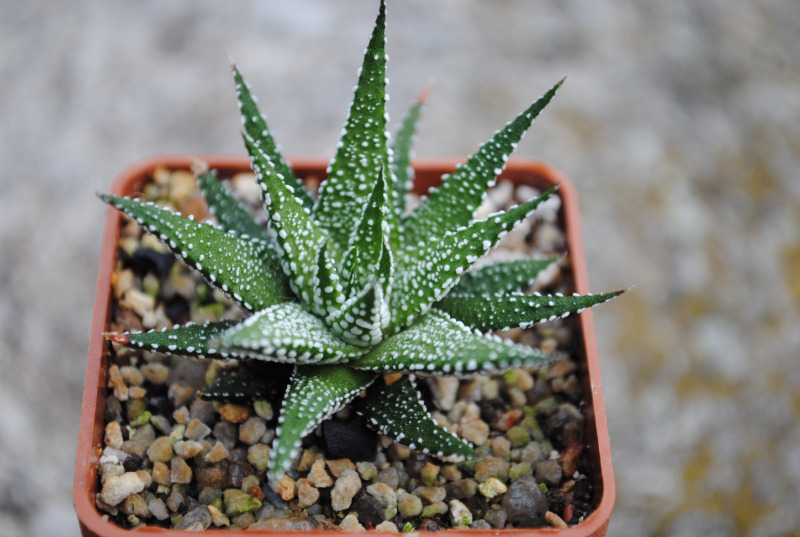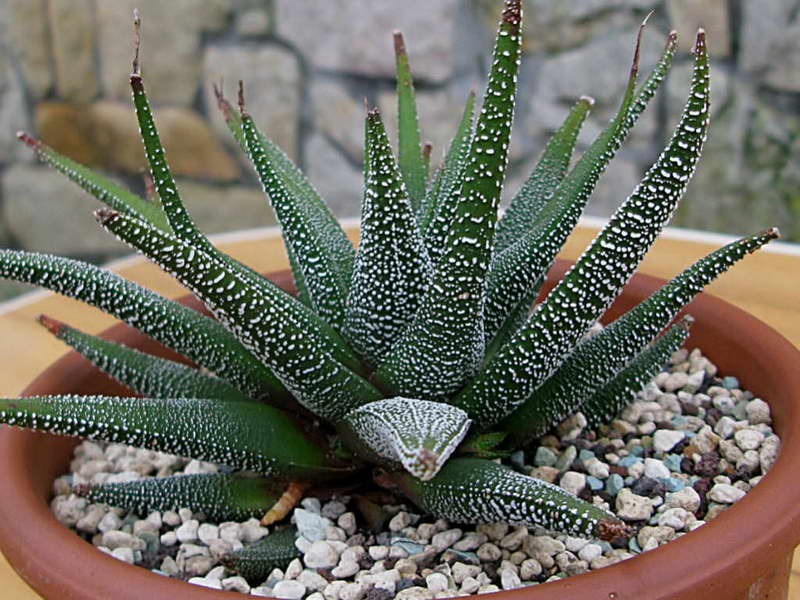The houseplant Haworthia is a member of the Asphodelic subfamily, which belongs to small succulents. Inexperienced growers may confuse it with aloe, but the beautiful and brighter appearance distinguishes the first plant from the medicinal one.

Variety of species
In the wild, Haworthia is widespread in South Africa. Elongated narrow leaves with white horizontal stripes look spectacular and give the plant originality. Moreover, there are several types of such home colors:
- Haworthia striped has white stripes on the leaves, reaching 5 cm in length.
- Cooper has spherical bubble leaves, inside of which there is a supply of water.
- Maugani resembles short and thick green columns.
- Terkovidnaya with leaves that seem to grow on top of each other.
- Retuza or pritulina is distinguished by its fleshiness, triangular elements.
- Checkerboard or mosaic has a checkered pattern on a green surface.
- Haworthia Reinwardt is an elongated rosette of short and thick petals.
Where to put and which pot to choose
For the effective cultivation of an indoor flower, it is worth choosing windows of the west, east or south side. The window should be kept open in hot and warm weather, but it is important to avoid drafts.
For planting, a round container with a volume of at least 1 liter is optimal. Root decay is possible in square ones. As the Hawortia grows, it is transplanted into a larger pot. In any case, there must be a hole for excess moisture and a stand.
Soil and drainage
Sod and leafy land in a ratio of 1: 1 is optimal for growing this flower. In this case, the soil should have a slightly alkaline or neutral reaction.
For better drainage, add about 30% fine gravel or brick chips to this mixture.
Planting and transplanting
Annual transplanting is one of the important conditions for growing haworthia. If the plant is adult, then it is possible to change the pot every two years.
In any case, prepare the soil, pour about 1 cm of fine gravel on the bottom of the container, then fill it up to half with soil, place the roots of the plant and sprinkle it almost to the top with earth.
Temperature and humidity
For good growth and development of Haworthia, an air temperature in summer is not lower than 15-20 ° C, and in winter about 12 ° C. The figures may be slightly higher, but drafts and gusts of cold wind must be excluded.
Since this flower is a succulent, any humidity in the room is suitable for good growth. The room in which the Haworthia is located must be regularly ventilated both in summer and winter.
Watering and spraying
In winter, it is enough to water an indoor flower once a month if the plant is in a cool room with an air temperature of no higher than 15 ° C. When the indicator is higher and the greenery grows, you can increase the frequency of watering up to 1 time in 2 weeks.
Spraying is best done in hot weather. In this case, water should not get between the leaves, inside the bush, which can lead to decay and the death of elements. Sometimes you can wipe the flower with a damp sponge.
Lighting
In summer, it is worth sticking a sun-protective film on the glass, which prevents the effect of scorching rays on the plant. Direct sunlight can be damaging to greenery.
In winter, there is no need for careful sun protection. If the room is poorly lit, then special plant lamps are suitable.
Top dressing and fertilizers
From April to August, it is recommended to fertilize once a month. Complexes are used for cacti, but the solution is made two times weaker than indicated in the instructions on the package.
This composition is watered with haworthia until autumn, when feeding should be stopped. From this period until spring, the greens practically does not grow, is at rest and does not need a lot of nutrients.
Pruning
The formation of dry leaves is the result of unfavorable conditions, for example, excessive dryness of the air, lack of irrigation, streams of hot wind from heating devices. In this case, you need to carefully cut off the damaged foliage, and also eliminate the cause. In winter, a protective wall barrier installed along the edge will help to fence off the flower on the windowsill.
The appearance of rot indicates an excess of moisture and watering should be stopped before the soil dries. If the plant is stretched in height, then you will need to transplant into a more spacious container and feed the Haworthia. Thus, rotten and dry leaves are removed with sharp scissors, and also eliminate the cause of spoilage.
The South African flower does not require special attention, it gets along well on the same windowsill with cacti and deciduous plants. It should be borne in mind that each type of greenery needs optimal conditions for growth.


